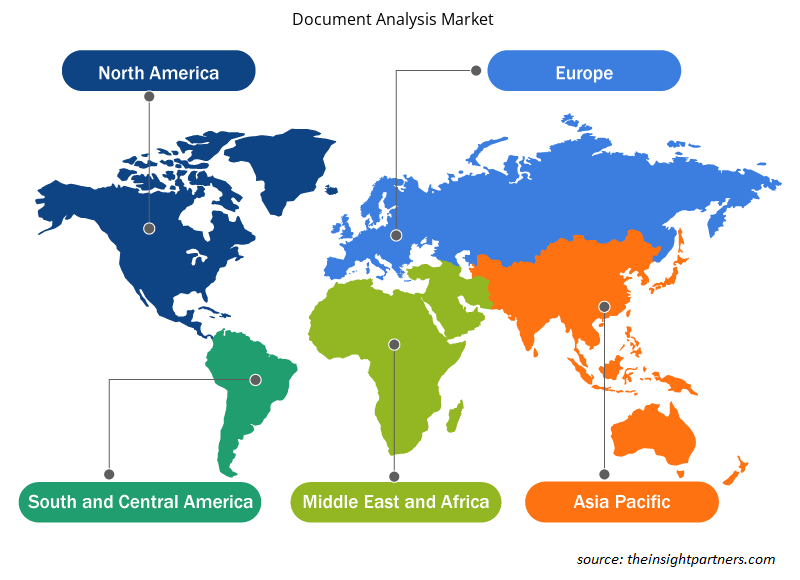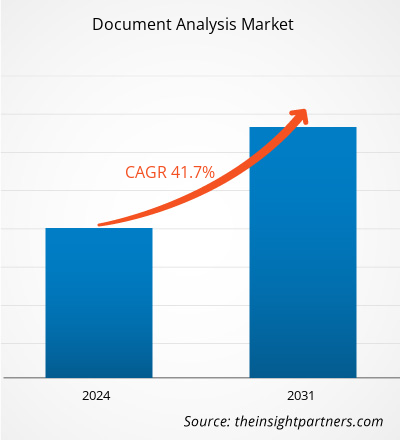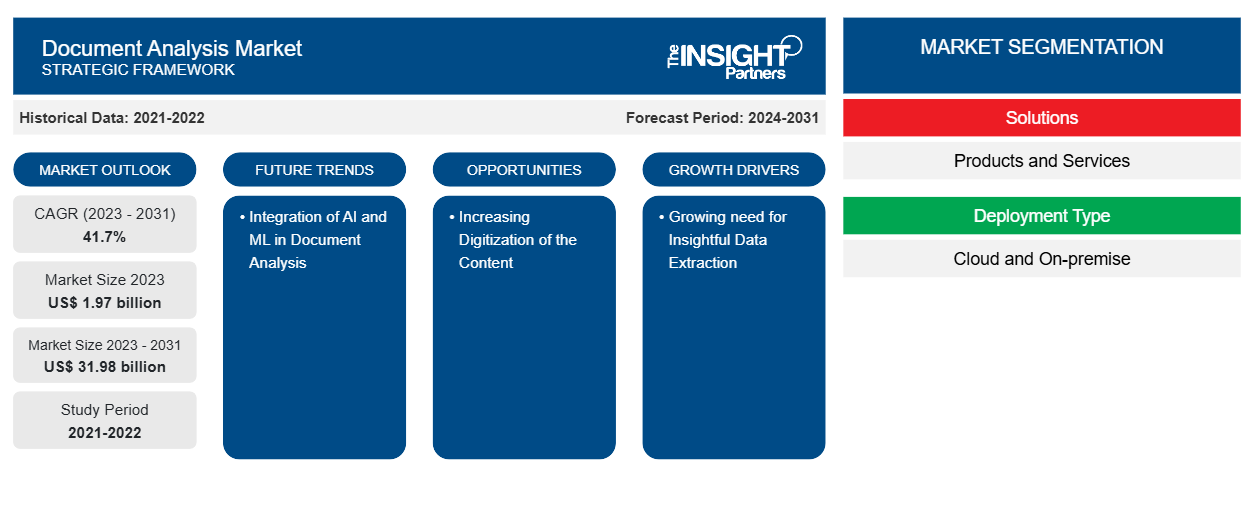Si prevede che la dimensione del mercato dell'analisi dei documenti raggiungerà i 31,98 miliardi di dollari entro il 2031, rispetto ai 1,97 miliardi di dollari del 2023. Si prevede che il mercato dell'analisi dei documenti registrerà un CAGR del 41,7% nel 2023-2031. La crescente inclinazione verso la digitalizzazione dei contenuti e la necessità di ricavarne informazioni.
Analisi dei documenti Analisi di mercato
L'analisi dei documenti offre alle aziende un approccio strutturato per estrarre in modo efficiente informazioni preziose da vari documenti. Le organizzazioni possono identificare modelli nascosti e prendere decisioni informate impiegando tecniche come l'analisi dei contenuti e sfruttando strumenti come OCR e software di analisi dei dati qualitativi.
Panoramica del mercato dell'analisi dei documenti
L'analisi dei documenti consente agli utenti di controllare automaticamente i dati con dati variabili. Consente agli individui di trovare informazioni preziose, rilevare modelli e trarre conclusioni da testi che vanno dai manoscritti storici ai documenti digitali contemporanei. I processi manuali non sono né accurati al 100% né convenienti, motivo per cui varie organizzazioni stanno implementando l'analisi dei documenti. Nel mondo degli affari, è fondamentale nell'analisi finanziaria, nella revisione dei contratti, nelle ricerche di mercato e nell'intelligence competitiva nel mondo aziendale. L'analisi di documenti aziendali come report finanziari, contratti e studi di mercato può aiutare le organizzazioni a prendere decisioni informate, capitalizzare le opportunità e identificare i rischi.
Personalizza questo report in base alle tue esigenze
Riceverai la personalizzazione gratuita di qualsiasi report, comprese parti di questo report, o analisi a livello nazionale, pacchetto dati Excel, oltre a usufruire di grandi offerte e sconti per start-up e università
-
Scopri le principali tendenze di mercato in questo rapporto.Questo campione GRATUITO includerà analisi di dati che spaziano dalle tendenze di mercato alle stime e alle previsioni.
Analisi dei documenti Driver di mercato e opportunità
Aumentare la digitalizzazione dei contenuti per favorire il mercato
Le aziende di tutto il mondo stanno digitalizzando i propri contenuti per semplificare le operazioni, ridurre i costi e migliorare i profitti. La digitalizzazione dei documenti aiuta le organizzazioni a convertire i documenti cartacei in formati digitali che possono essere archiviati, modificati, consultati e condivisi online. Ad esempio, nell'ottobre 2022, uno studio ha osservato che le organizzazioni indiane erano determinate ad aumentare i propri investimenti in queste capacità del 25% nei successivi 12 mesi. Il sondaggio ha visto il coinvolgimento di 150 decisori aziendali in Australia-Nuova Zelanda, India e Singapore. Le aziende stanno aumentando la dipendenza e stanno optando per flussi di lavoro di documenti digitalizzati. La digitalizzazione e la creazione di contenuti aiutano le organizzazioni a semplificare i propri flussi di lavoro, migliorare la sicurezza, ridurre i costi e migliorare la produttività. Pertanto, la digitalizzazione di tutti i contenuti aiuta le organizzazioni ad automatizzare, analizzare e confrontare documenti complessi, completamente affidabili, automatizzati e indipendenti dal formato e dalla struttura dei file da controllare. La digitalizzazione dei contenuti consente il controllo a campione, che aiuta a ricavare informazioni immediate e significative. Pertanto, la crescente digitalizzazione dei contenuti guida la crescita del mercato dell'analisi dei documenti .
Crescente necessità di estrazione di dati approfonditi.
La gestione efficiente dei dati è fondamentale per la produttività e il successo aziendale. L'analisi dei documenti consente di semplificare i processi correlati ai documenti, consentendo alle organizzazioni di trarre informazioni preziose, migliorare il processo decisionale e ottimizzare i flussi di lavoro. Automatizza l'estrazione di informazioni rilevanti da documenti non strutturati come fatture, contratti e report. Sfruttando algoritmi avanzati, identifica i punti dati chiave (ad esempio, importi delle fatture, date di scadenza, dettagli del fornitore) e popola database o sistemi aziendali. Ad esempio, considera un reparto contabilità fornitori che riceve centinaia di fatture al giorno. Il software di analisi dei documenti può estrarre rapidamente i dati delle fatture, riducendo gli errori di immissione manuale dei dati e accelerando l'elaborazione dei pagamenti.
Analisi dei documenti Rapporto di mercato Analisi della segmentazione
I segmenti chiave che hanno contribuito alla derivazione dell'analisi di mercato dell'analisi dei documenti sono le soluzioni, il tipo di distribuzione, le dimensioni dell'organizzazione e il settore verticale.
- In base alle soluzioni, il mercato dell'analisi dei documenti è segmentato in prodotti e servizi.
- In base al tipo di distribuzione, il mercato dell'analisi dei documenti è segmentato in cloud e on-premise.
- In base alle dimensioni dell'organizzazione, il mercato dell'analisi dei documenti è segmentato in grandi imprese e piccole e medie imprese (PMI).
- In base ai settori verticali del settore, il mercato dell'analisi dei documenti è segmentato in BFSI, governo, sanità, commercio al dettaglio, produzione e altri.
Analisi dei documenti Analisi della quota di mercato per area geografica
L'ambito geografico del report di mercato sull'analisi dei documenti è principalmente suddiviso in cinque regioni: Nord America, Asia Pacifico, Europa, Medio Oriente e Africa e Sud America/Sud e Centro America. Le aziende in tutto il Nord America hanno adottato sempre più documenti digitali , richiedendo soluzioni di analisi dei documenti. Inoltre, le economie in crescita come Europa e Asia Pacifico stanno adottando l'analisi dei documenti.
Analisi dei documenti Approfondimenti regionali di mercato
Le tendenze regionali e i fattori che influenzano il Document Analysis Market durante il periodo di previsione sono stati ampiamente spiegati dagli analisti di Insight Partners. Questa sezione discute anche i segmenti e la geografia del Document Analysis Market in Nord America, Europa, Asia Pacifico, Medio Oriente e Africa, e Sud e Centro America.

- Ottieni i dati specifici regionali per il mercato dell'analisi dei documenti
Ambito del rapporto di mercato dell'analisi dei documenti
| Attributo del report | Dettagli |
|---|---|
| Dimensioni del mercato nel 2023 | 1,97 miliardi di dollari USA |
| Dimensioni del mercato entro il 2031 | 31,98 miliardi di dollari USA |
| CAGR globale (2023-2031) | 41,7% |
| Dati storici | 2021-2022 |
| Periodo di previsione | 2024-2031 |
| Segmenti coperti |
Per Soluzioni
|
| Regioni e Paesi coperti |
America del Nord
|
| Leader di mercato e profili aziendali chiave |
|
Analisi dei documenti Densità degli attori del mercato: comprendere il suo impatto sulle dinamiche aziendali
Il mercato del Document Analysis Market sta crescendo rapidamente, spinto dalla crescente domanda degli utenti finali dovuta a fattori quali l'evoluzione delle preferenze dei consumatori, i progressi tecnologici e una maggiore consapevolezza dei vantaggi del prodotto. Con l'aumento della domanda, le aziende stanno ampliando le loro offerte, innovando per soddisfare le esigenze dei consumatori e capitalizzando sulle tendenze emergenti, il che alimenta ulteriormente la crescita del mercato.
La densità degli operatori di mercato si riferisce alla distribuzione di aziende o società che operano in un particolare mercato o settore. Indica quanti concorrenti (operatori di mercato) sono presenti in un dato spazio di mercato in relazione alle sue dimensioni o al valore di mercato totale.
Le principali aziende che operano nel mercato dell'analisi dei documenti sono:
- Lavori Ant
- Automazione ovunque, Inc.
- Celatone
- Servizi globali Datamatics Limited
- Sistemi di estrazione
- Tecnologie HCL
Disclaimer : le aziende elencate sopra non sono classificate secondo un ordine particolare.

- Ottieni la panoramica dei principali attori del mercato dell'analisi dei documenti
Analisi dei documenti Notizie di mercato e sviluppi recenti
Il mercato dell'analisi dei documenti viene valutato raccogliendo dati qualitativi e quantitativi dopo la ricerca primaria e secondaria, che include importanti pubblicazioni aziendali, dati associativi e database. Di seguito è riportato un elenco degli sviluppi nel mercato:
- A settembre 2023, - Ocrolus ha lanciato un'elaborazione dei documenti completamente automatizzata che offre informazioni in pochi secondi. Il prodotto lanciato Instant è un servizio basato sull'intelligenza artificiale che consente ai creditori di analizzare in modo efficiente estratti conto e altri documenti finanziari più che mai.
(Fonte: Ocrolus, Comunicato stampa, 2023)
- Nel luglio 2022, la società canadese di controllo qualità dei documenti GlobalVision ha lanciato l'ultima innovazione nella tecnologia di correzione di bozze per la conformità del settore denominata Text Inspection 2; questo algoritmo, un aggiornamento del sistema di correzione di bozze basato su cloud Verify dell'azienda, definisce un nuovo standard di velocità e accuratezza nella lettura e nell'analisi dei documenti digitali.
(Fonte: Palo Alto, Comunicato stampa, 2021)
Copertura del rapporto di mercato dell'analisi dei documenti e risultati
Il rapporto "Dimensioni e previsioni del mercato dell'analisi dei documenti (2021-2031)" fornisce un'analisi dettagliata del mercato che copre le seguenti aree:
- Dimensioni e previsioni del mercato a livello globale, regionale e nazionale per tutti i segmenti di mercato chiave coperti dall'ambito
- Dinamiche di mercato come fattori trainanti, vincoli e opportunità chiave
- Principali tendenze future
- Analisi dettagliata delle cinque forze PEST/Porter e SWOT
- Analisi di mercato globale e regionale che copre le principali tendenze di mercato, i principali attori, le normative e gli sviluppi recenti del mercato
- Analisi del panorama industriale e della concorrenza che copre la concentrazione del mercato, l'analisi della mappa di calore, i principali attori e gli sviluppi recenti
- Profili aziendali dettagliati
- Analisi storica (2 anni), anno base, previsione (7 anni) con CAGR
- Analisi PEST e SWOT
- Valore/volume delle dimensioni del mercato - Globale, Regionale, Nazionale
- Industria e panorama competitivo
- Set di dati Excel
Report recenti
Testimonianze
Motivo dell'acquisto
- Processo decisionale informato
- Comprensione delle dinamiche di mercato
- Analisi competitiva
- Analisi dei clienti
- Previsioni di mercato
- Mitigazione del rischio
- Pianificazione strategica
- Giustificazione degli investimenti
- Identificazione dei mercati emergenti
- Miglioramento delle strategie di marketing
- Aumento dell'efficienza operativa
- Allineamento alle tendenze normative























 Ottieni un campione gratuito per - Analisi dei documenti di mercato
Ottieni un campione gratuito per - Analisi dei documenti di mercato